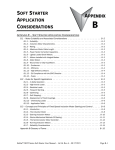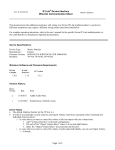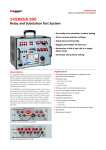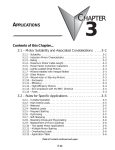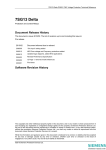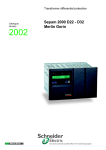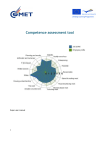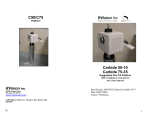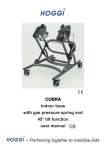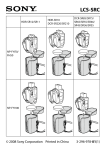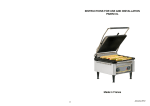Download Stellar SR55 Soft Starter User Manual SR55-M
Transcript
Principles of iERS (intelligent Energy Recovery System) Chapter 4 Chapter 4 – Principles of iERS (Intelligent Energy System) Principles of the iERS���������������������������������������������������������������������������������������������� 4–2 Principles ���������������������������������������������������������������������������������������������������������������������� 4–2 Advantages of iERS������������������������������������������������������������������������������������������������������ 4–3 How Much Energy?������������������������������������������������������������������������������������������������������� 4–4 Estimating Energy Savings������������������������������������������������������������������������������������������� 4–5 iERS with the SR55 System ���������������������������������������������������������������������������������������� 4–6 Chapter 4 Glossary of Terms���������������������������������������������������������������������������������� 4–7 Stellar® SR55 Series Soft Starter User Manual – 1st Ed. Rev.A – 08/17/2015 Page 4–1 Chapter 4: Principles of iERS (intelligent Energy Recovery System) Principles of the iERS Principles Every wound-field electric motor must consume some minimum amount of energy to provide a magnetic field which enables it to work at all. With DC motors the field is under separate control, so that the amount of magnetizing energy can be adjusted to be sufficient to overcome losses and provide an armature reaction appropriate to the load. The squirrel cage AC induction motor has no such provision, with the result that energy is wasted at any load less than its rated full load (at full speed). When a squirrel-cage motor is supplied at a constant terminal voltage, as when it is connected directly to the supply without a controller of any kind, the strength of the field flux is fixed by the supply voltage. At normal running speed the field will take a fixed quantity of energy regardless of the torque demanded by the mechanical load. The energy required to support the load torque is determined by the torque demand. As load torque increases, the rotor slows down a little (i.e. ’slip’ increases), causing induced rotor currents to also increase in order to increase the torque. These additional currents in the rotor are balanced by additional current in the stator coils. Conversely, if load torque demand falls, the slip decreases, the rotor currents decrease, and the current in the stator decreases accordingly. But at constant terminal voltage, the current providing the stator field flux remains unchanged at any level of load torque demand. As a consequence, the efficiency of an induction motor decreases as the load decreases. Figure 4.1.1: Typical duty cycle for a machine load where the Torque Demand varies. Load Torque Demand at working speed 100 50 M demand % 0 40 60 seconds 80 100 120 140 160 Figure 4.1.2: Torque Demand converted to an equivalent current with the motor magnetizing current added Current Demand due to torque and flux 100 Magnetizing current Torque current 50 % FLC 0 Page 4–2 40 60 seconds 80 100 120 140 160 Stellar® SR55 Series Soft Starter User Manual – 1st Ed. Rev.A – 08/17/2015 Chapter 4: Principles of iERS (intelligent Energy Recovery System) Advantages of iERS A soft starter with an iERS energy-optimizing feature alters the motor operation. The iERS function reduces the terminal voltage applied to the motor so that the energy needed to supply the field is more closely proportioned to the torque demand. The effect is shown in the Figure below. Figure 4.2.1: ‘Full Speed’ end of the conventional Torque/Current curves. The present considerations do not affect soft-starting options or strategies. Voltage/Torque balance Torque at rated voltage Torque at reduced voltage 100% M Full load Torque at rated voltage A B Reduced Torque demand Point A on the current curve is the operating point of the motor when the motor terminal voltage is at its ‘nominal’ or rated value, and when the load is the maximum for which the motor is rated. If the load decreases, a motor supplied at a fixed voltage will speed up slightly, the current demand will reduce, and the operating point moves along the curve to Torque point “B”. Because the torque developed Speed Synch by a motor is proportional to the square of the applied voltage, lowering the terminal voltage reduces the torque. If the reduced voltage is correctly chosen, the working point at the reduced torque demand becomes the point “A”. By reducing the terminal voltage, the motor has in effect been ‘exchanged’ for one which has a lower rated power output. A reduced terminal voltage also means a reduced field energy requirement, and this simple relationship enables the iERS function to maintain the efficiency of the motor over nearly the entire load range from ‘no load’ upwards. In practical terms, ‘no load’ means no external load. There are still internal mechanical and electrical losses to overcome – friction and windage of the rotor at speed, and the electrical heating and hysteresis losses. The ideal response to the ‘no load’ condition would be to supply precisely the amount of magnetizing current needed to provide the armature reaction to balance the losses. This is what the iERS seeks to do automatically and continuously. 80% M Additional Benefits in Practice It is normal to select a standard motor with a rating somewhat higher than the maximum demand of the driven load. The motor selected for any given application will almost certainly be over-rated for this reason alone, and therefore energy could be saved even at full load when supplied at rated voltage. Furthermore, there are those applications where the size of motor has to be chosen to provide for high loadings which occur only intermittently, or for an arduous start, even though the load demand at most times is much lower. Stellar® SR55 Series Soft Starter User Manual – 1st Ed. Rev.A – 08/17/2015 Page 4–3 Chapter 4: Principles of iERS (intelligent Energy Recovery System) How Much Energy? The amount of energy used by a squirrel-cage induction motor operating with a soft starter in energy-optimizing (iERS) mode is shown in the following figure (Figure 4.5.1), for the same duty cycle as Figure 4.1.2. By reducing the voltage when torque demand is below maximum, the magnetizing current is proportioned to the torque current. Compare Figure 4.5.1 (energy-optimizing) with Figure 4.1.2 (non-optimizing). (These graphical representations are illustrative only and not to scale.) Arriving at any exact figure for the energy cost saved requires each individual case to be examined in detail, taking into account the motor rating, type, and any special characteristics such as load, load characteristics, duty cycle, supply voltage, and the cost of electricity. Figure 4.5.1: Energy Savings Current demand with Energy Saving in operation 100 Magnetizing current Torque current 50 % FLC 0 40 60 seconds 80 100 120 140 160 The calculations to cover all the likely or possible conditions would be laborious. An empirical method for arriving at a usefully realistic estimate has been devised. Used with a proper sense of engineering circumspection, the tables in the “Estimating Energy Savings” sub-section allow a user to gain a reasonably close estimate of the savings to be achieved within the motor by using the SR55 optimizing soft starter. The method does not include any additional savings and benefits conferred by other sources, such as: • reduction of heating losses in cabling because of the lower voltages; • potential reduction of maximum demand charges; • further energy savings and other benefits deriving from the soft-starting process itself; • reduced total energy demand; • reduced wear and tear; • reduced maintenance and replacement costs. Page 4–4 Stellar® SR55 Series Soft Starter User Manual – 1st Ed. Rev.A – 08/17/2015 Chapter 4: Principles of iERS (intelligent Energy Recovery System) Estimating Energy Savings Basis for estimations: • 3-phase squirrel cage induction motor, standard type. • Supply: 380 to 440V, 50Hz. • Supply voltage > minimum working voltage on motor rating plate. • Operation 30% rated nameplate full load. Table 4.6.1: Estimations Energy Savings Estimations – Table 4.6.1 Estimated Savings Motor Size kW HP (% rated kW) Less than More than 5 22.5 55 110 110 7.5 30 75 150 150 10 6.5 3.5 2.5 1.5 Table 4.6.2: Modifying Factors Energy Savings Modifying Factors – Table 4.6.2 Motor Poles Motor Slip Number of Poles Add (% kW) % Slip Add (% kW) 2 4 6 8 -0.5 0 0.5 1 0.5 2 3.3 5 -0.5 0 0.5 1 Examples of estimated energy savings: 1) 37.5 kW 4-pole motor From Table 1, use the estimated savings figure for the next higher rating, i.e. 55 kW. The savings would be approximately 3.5% x 37.5 kW = 1.3125 kW. For the 30% loaded motor, the savings are 1.3125 kW / (30% x 37.5 kW) = 11.6% savings. 37.5 kW 2-pole motor From Table 1, use the estimated savings figure for the next higher rating, i.e. 55 kW. From Table 2, apply the pole-number factor of -0.5 %. The savings would be approximately (3.5 % - 0.5 %) x 37.5 kW = 1.125 kW. For the 30% loaded motor, the savings are 1.125 kW / (30% x 37.5 kW) = 10% savings. 37.5 kW 2-pole ‘low slip’ motor From Table 1, use the estimated savings figure for the next higher rating, i.e. 55 kW. From Table 2, apply the pole-number factor of -0.5 % and the %-slip factor of -0.5%. The savings would be approximately (3.5 % - 0.5 % - 0.5 %) x 37.5 kW = 0.938 kW. For the 30% loaded motor, the savings are 0.938 kW / (30% x 37.5 kW) = 8.3% savings. Stellar® SR55 Series Soft Starter User Manual – 1st Ed. Rev.A – 08/17/2015 Page 4–5 Chapter 4: Principles of iERS (intelligent Energy Recovery System) iERS with the SR55 System During start-up, the SR55 software uses a patented method to compute and store a reference value for the power factor. When the motor has reached full speed and is driving the load at the demanded torque, the SR55 enters the ‘motor running’ stage. At this stage, if required, the motor may also operate in ‘iERS Mode’. Entering this mode can be pre-set from the SR55 touchscreen and stored for automatic operation, which will suit the majority of applications where it is required. This is the default operating mode for the SR55. It can also be toggled on and off while running by using either the iERS button in the Advanced Settings of the touchscreen, or through external circuitry connected to one of the programmable inputs and controlled by the driven process. ‘iERS’ Intelligent Energy Recovery System will sense when at a level where we will gain no benefits from Energy Saving, the SR55 will energize the bypass relays, and there will be no losses from the motor controller. Energy Saving will try to be active at all times and is fully automatic. The bypass relays will only energize depending upon the measured thermal capabilities of the unit, percentage loading of the motor, and the power factor, etc. The bypass relays will open at 80% loading of the motor current set and enter the energy saving mode. The relays will not re-energize until at least we are a level of 90% of the motor current set, or we have surpassed the measured thermal capabilities of the unit, or the power factor is close to full loading. There should be even higher levels of energy saving, as when the motor is fully loaded the relays will be energized and we will have no losses in the thyristors. We will therefore gain maximum saving which is especially beneficial on typical cyclic loading applications such as pump jacks, injection molding machines, mixers, saws, etc. In iERS mode the reference power factor is continuously compared with the running power factor. The software continuously uses this comparison to compute and adjust the firing point of the thyristors in order to maintain the best power factor. This method of continuous control minimizes wasted energy caused by overfluxing the motor. It also maintains the power factor at the most appropriate value for every condition of load demand. This can produce a significant reduction in the kVA demand. This is an operating condition that may, at light or partial load conditions, provide the benefit of energy saving and if selected, is continuous from the dwell period until a STOP command is initiated or the mode is disabled. It should be noted that this function is inhibited by the software if the current being drawn by the motor exceeds 80% of the set current of the SR55 (at full voltage when the motor enters its running stage with the iERS mode selected). The method of power factor management described does not affect motor performance, nor does it detract from the motor’s capability to respond to changes in load demand. This feature of the SR55 Soft Starter is a purely electrical function which has the effect of ensuring that the motor delivers the torque demanded at all times, but allows it to draw only the precise amount of magnetizing current required to support that torque output. Without this feature, the motor would draw the maximum magnetizing current regardless of load. The iERS function cannot improve the power factor beyond what it would ordinarily be at full load, but it does make the optimum improvement possible at any partial load. Page 4–6 Stellar® SR55 Series Soft Starter User Manual – 1st Ed. Rev.A – 08/17/2015 Chapter 4: Principles of iERS (intelligent Energy Recovery System) Chapter 4 Glossary of Terms Breakaway Torque: The minimum torque required to achieve rotor movement for the motor with its load. Current Limit: The current at which the ramp is held. For the SR55, current limit is only active during start-up where it contributes to the motor control function. This feature is particularly useful when starting high-inertia loads that require an extended start-up period. (See also Overload Level.) Direct-On-Line (DOL): The direct connection and disconnection of a motor from the AC main supply by means of a contactor or switch. Acceleration and operation is at full mains voltage only. iERS: Intelligent Energy Recovery System. An advanced motor control technology proven to reduce the energy consumed in fixed speed motor applications. It matches the power consumption to the load required by intelligently monitoring and regulating energy consumption, voltage, current, and power factor during the motor starting and running stages. iERS automatically bypasses itself when it is not needed, and continues monitoring to re-engage itself as needed. Inrush Current or Locked Rotor Current: The current that flows at the instant of connection of a motor to the power source. It is limited by the impedance presented by a de-energized motor and the applied voltage. Usually expressed as a multiple of motor full-load current. Kick-start Voltage: The percentage of supply voltage applied before commencing ramp-up when a load has a high breakaway torque and the standard settings of pedestal voltage may not allow sufficient torque to be developed by the motor to cause acceleration. Locked Rotor Current: Same as Inrush Current (defined above). Overload Level: The level of current at which the controller overload begins to integrate. For the SR55, the overload detector is always active and provides protection against prolonged over-current operation. Pedestal Voltage: The voltage that the unit applies to the motor at start-up. It is expressed as a percentage of the rated supply voltage. Power Factor: The ratio, expressed as a trigonometric cosine, of the real power consumption to the apparent power consumption. Topof Ramp (TOR): The unit achieves Top of Ramp (TOR) when it completes the start-up stage of motor control. (This occurs when the voltage applied to the motor first equals the main supply voltage.) Soft-start: The regulation, by electronic means, of the supply voltage from an initial low value to full voltage during the starting process. This overcomes the inherent drawbacks of a switched supply. The motor torque is modified in proportion to the square of the voltage applied. Trip: A trip occurs when the unit removes power to the motor because its operation equals the limit imposed by one of its self-protection features. Stellar® SR55 Series Soft Starter User Manual – 1st Ed. Rev.A – 08/17/2015 Page 4–7 Chapter 4: Principles of iERS (intelligent Energy Recovery System) BLANK PAGE Page 4–8 Stellar® SR55 Series Soft Starter User Manual – 1st Ed. Rev.A – 08/17/2015








